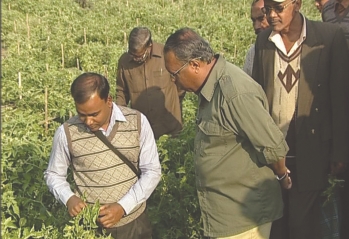FARMERS’ VOICE
Jamalpur
Nightmares of the Nightshade Family
Standing beside the Brahmaputra river in Jamalpur district, as far as the eyes can see, layfields of tomatoes, a vegetable which belongs to the nightshade family. Tomato production has increased in this part of Bangladesh. Meanwhile, many farmers' incomes have become economically sustainable. But, this season, no matter how good the tomatoes look from afar, the real picture is not what it actually seems, where a nightmare has befallen the nightshade family.
.................................................................................................
Shykh Seraj
| |
 |
| |
SAAO Suja trying to explain what has happened but couldn't |
Over the last ten years, farmers infrequently produced tomatoes at Kuchondhora char land over Brahmaputra river, situated in Jamalpur Sadar. But, in the last five years, tomato farming expanded rather incredibly. The result of the extension was so enormous that now around 3,000 farmers are cultivating tomato on over 2,500 bighas (833 acres) of land. But a great disaster has befallen them.
The Predicament
In Bangladesh, I've never seen tomato fields, stretching nearly five to six kilometers, or you may say I've never seen tomatoes, grown on more than 833 acres of lands. When I reached a tomato field, farmers wore a gloomy and uncomfortable look. At the beginning, some of them actually tried to tell me something, a problem which is not clear to them but one that has become so huge. Their tomato-leaves are curling and eventually the plants die at the very beginning of the season. And the problem spreads fast! They went to the Agriculture Department, seed and pesticide companies and came back without any solution. It was time to unveil the mystery.
“All the plants have curled,” says Abu Taher, a farmer, while pointing to his produce. “Most of the plants over there are ruined.”
“Why do you think this problem has occurred?”, I asked.
“None of us know”, replied Abu.
Almost 95% of the plants look like this, I mean they look 'curled'. All the plants were fresh at the beginning, but suddenly the catastrophe hit us from nowhere. Some of the farmers were actually eager to tell me more. Finally one charged-up farmer came in front and said, “Plants go ruined using the poor-quality seeds. When we return the poor-quality seeds, I believe they mix it up with the new ones just to sell those again.”
“Because of the virus, the plants curl…looks reddish. Due to the problem, we sowed new seeds, but the problem occurred once again”, added another farmer. Well, finally they were opening up.
Off-course
Officers from the Agriculture Department also came to the field while I was talking with these hapless farmers. I talked with local SAAO (Sub Assistant Agriculture Officer), Shahidullah Al Suja. He explained that the leaves are curling because of a virus attack. When I asked him whether they went through proper examinations to find out the real problem here, he told me scientists have been to Laxmi char land and found similar symptoms which farmers are facing, here in Kuchondhora. How could the result of Laxmi charland be the example for Kuchondhora when no scientists actually ran any tests here? I was so surprised and felt very sad for the poor farmers who are the real sufferers. How could those who are their possible saviours act so irresponsibly?
Plant Protection Expert of the DAE (Department of Agricultural Extension), Pradip Kumar Saha tried to explain the situation in a more elaborated way. He told me that as a result of constant 10-12 years of tomato farming on the same land, the soil faces a really high rate of bacteria multiplication. “Researchers often say if water from the bacteria-infected land slither away to another fresh land, it also gets infected”, said Mr. Kumar. He also stressed that the virus can spread through various means, even from Lungi (loin-cloths) and that the contamination level is really high. “I requested them not to use any pesticides for either bacteria or virus. In that case their money will be spent in vain”, boldly claimed the expert.
Deputy Director of DAE, Mr. Abul Kashem was also present on the field. I asked him whether he's aware of this grave crisis and the answer was affirmative. I wanted to know whether their scientists have taken any sample from this region. He was affirmative and positive again. Once I gave him reference of Mr. Suja (SAAO) who told me couple of minutes back that scientists worked only on Laxmi charland and have matched the result with Kuchondhora, while not even visiting and working here, he replied, “This charland (Kuchondhora) and the Laxmi charland is the same”. I was not convinced, neither were the farmers.
The Deputy Director also said that they have prepared a report after this predicament and instantly read the report loud in front of all the farmers. But, the report only has the “do-s and don't-s” of next season's tomato farming. There's no clear indication in the report regarding the problem at hand. There's no precautionary message for farmers. No solutions…it only depicts primary tomato farming techniques. It wasn't a complete report which reflects the current crisis at all. When I voiced these comments, Mr. Abul Kashem agreed with me and the farmers, finally. It is sad and quite frightening to see is how farmers are neglected in a country where most people are farmers by profession.
Hide and Seek
Abdul Hannan, a tomato farmer got excited and came forward. “You know what the pesticide companies did?” I was so eager to know.
“We're illiterate people, we don't know anything… so they took advantage. They told us to rush for pesticides immediately. We went there, bought pesticides and started applying it as suggested by them”, said the angry farmer.
“What was the result”, I asked.
“You can see the result. I am ruined”, said Hannan.
There's also the issue of colour of the tomato seeds, which were all white in the past. That's also causing the problem, according to some of the farmers.

How insects avoids the pesticide, describes a farmer
Pesticide companies take advantage of these simpleton farmers, using convincing words. Same is true for the seed companies. All of us, including the farmers and state-authority should stand against these mischievous people who are against the agricultural development of Bangladesh. Farmers believe tomato leaves have curled due to the acidic effect of the pesticides they use. Moreover, farmer Abu Taher showed me how the insects are not being affected by the pesticides. It was really interesting to see how an insect actually escapes the pesticide and is easily able to travel from one plant to the other. “I have used different pesticides, but nothing could beat the insects”, said the troubled farmer. The fact of the matter remains, which is that no one really knows what going wrong with these tomatoes. Many people have various thoughts and beliefs, but no thorough scientific investigation has been carried out to identify the source of the crisis.
Where shall the farmers go? They listened to everyone's advice. None of them worked. They have been suggested to use seeds, growth hormones, pesticides. They went to many doors for suggestions, and that has made the bad situation worse. Pest control experts should have reached remote villages to provide advice to the farmers. Nothing like that has happened in Kuchondhora. There could only be few exceptional cases where pest control experts visited such places, but exceptions can't be the examples.
Only the Wearer Knows where the Shoe Pinches
Farmers are the sufferers. The lands represent the suffering this season. Tomato farmers won't even earn enough to cover production costs, forget about the profit. Farmers should harvest around 120-150 maunds per bigha land. Even if the total per bigha is 120 maunds, then there should be at least 0.3 million maunds in total. The price during the mid-season per maund is Tk. 400 and farmers should be counting Tk. 12 crore. One third of that (Tk. 4 crore) is already now at the graveyard. This is unexpected and a great loss for the agricultural economy.
Farmers need timely advice from the Agriculture Department. That is the only way the success which has emerged in the large char land of Kuchondhora can continue moving ahead without any disaster. I earnestly request the Agriculture Department and all the farming related commercial and non-commercial organizations to stand beside tomato farmers of Kuchondhora at their time of need.
Perhaps they won't come back from the loss right away, but they definitely will be back on their feet in a few seasons. They will wake from this nightmare. Farmers of Bangladesh are the most resilient; they will wake to a better dream.
***
|
Shykh Seraj is an Agriculture Development and Media Activist. He is Director and the Head of News at Channel i and also the Director, Planner and Presenter of the popular Agro-Documentary “Hridoye Mati O Manush”. |
Copyright
(R) thedailystar.net 2012 |



